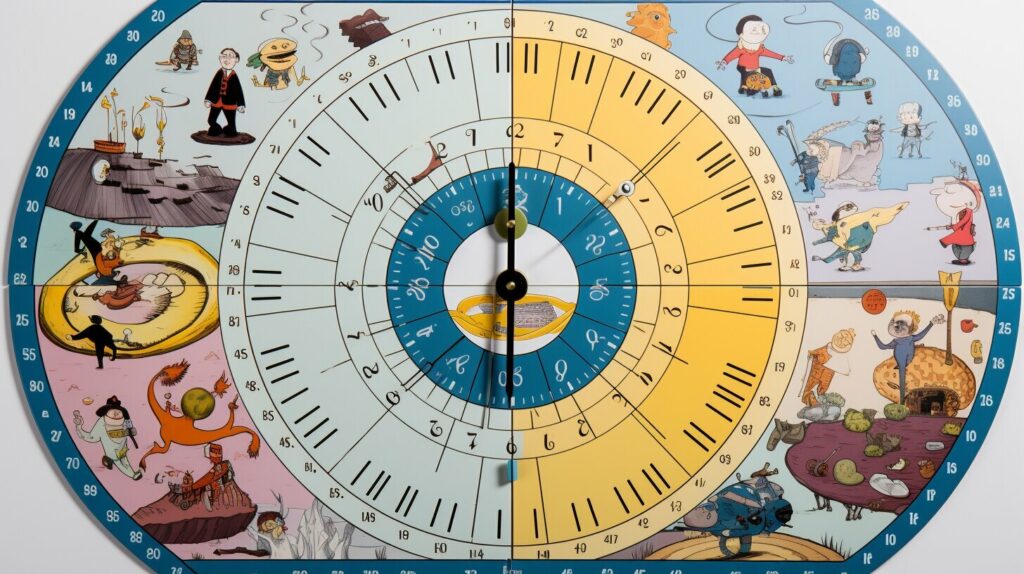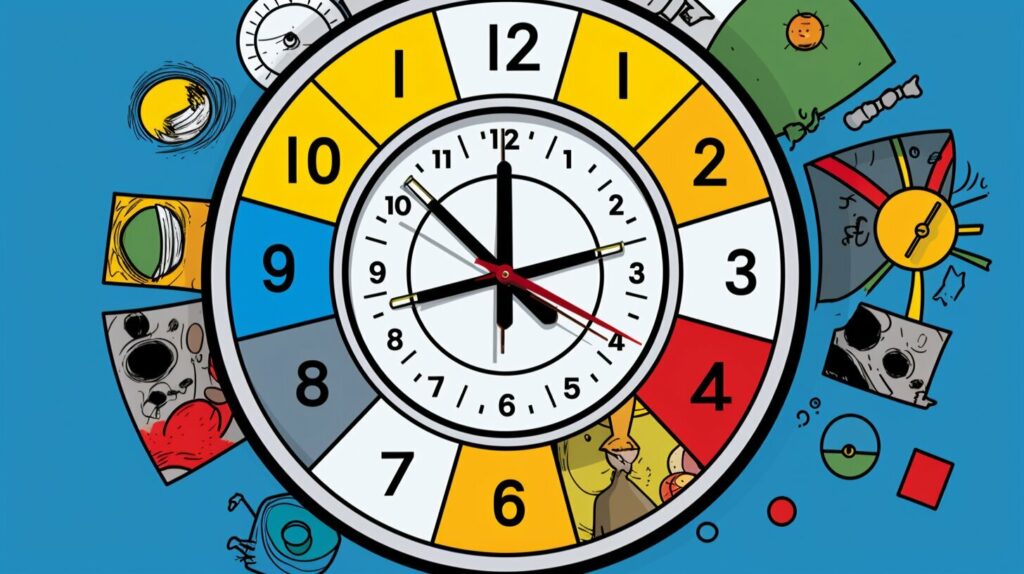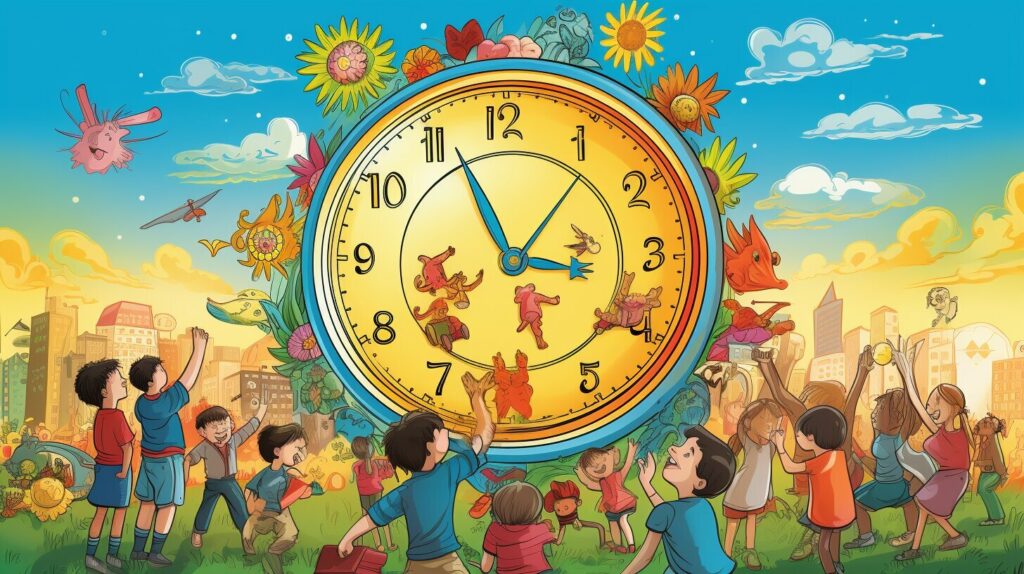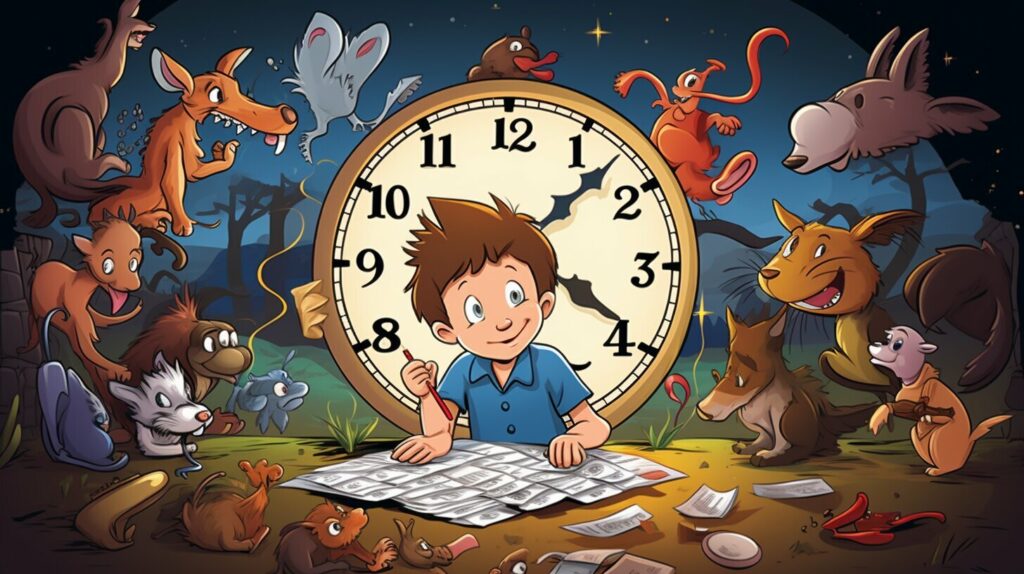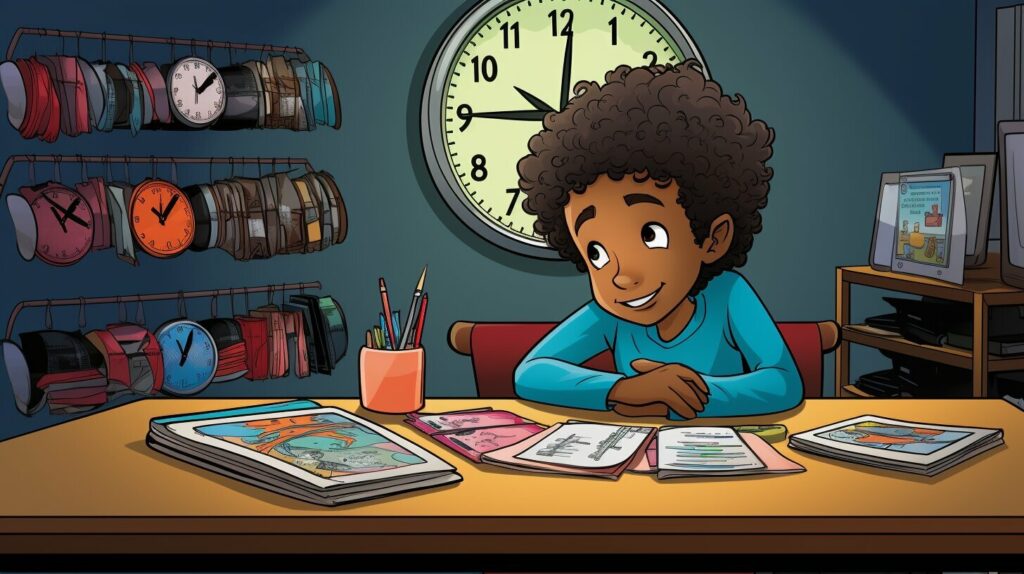
Making it Simple: How to Explain Time to a Child
Teaching children about time is an essential skill that can be challenging for parents. Time is an abstract concept that young children may struggle to grasp initially. However, with the right approach and guidance, parents can help their children understand and master the concept of time.
Understanding time is not only important for practical reasons, such as keeping appointments and managing daily routines, but it also helps children develop a sense of structure, responsibility, and independence. By teaching children about time from a young age, parents can set a solid foundation for their future growth and development.
Key Takeaways:
- Teaching children about time is crucial for their overall development and independence.
- The concept of time can be challenging for young children to understand initially.
- By using practical examples and engaging activities, parents can make time more relatable and easier to comprehend.
- Starting with basic concepts such as daily routines and gradually progressing to telling time on an analog clock can help children build a strong foundation.
- Reinforcing time-telling skills through hands-on activities and teaching time management can further enhance children’s understanding of time.
Why Teach Children About Time at a Young Age
Teaching children about time at a young age has numerous benefits and can greatly contribute to their overall development. By introducing them to the concept of time early on, parents can help children develop essential skills that will serve them well throughout their lives. Here are a few reasons why teaching children about time is important:
- Developing Time Management Skills: Understanding time allows children to develop crucial time management skills. By learning to allocate their time effectively, they can prioritize tasks, set goals, and establish routines. These skills are vital for success in school, extracurricular activities, and later in their professional lives.
- Enhancing Daily Life: Knowing how to read a clock and understand time enables children to navigate their daily routines more smoothly. They can better anticipate events, such as meal times, playtime, and bedtime. This helps create a sense of structure and predictability, which can have a positive impact on their well-being.
- Promoting Independence: Understanding time empowers children to take responsibility for their own activities and schedules. They can learn to manage their time effectively, complete tasks on time, and make informed decisions about how to allocate their time. This promotes independence and self-reliance.
- Strengthening Math Skills: Learning to tell time involves basic math concepts, such as counting, adding, and recognizing patterns. By engaging with these concepts in a practical context, children can strengthen their math skills in a meaningful way. This lays a foundation for future mathematical learning.
- Increasing Cognitive Development: Grasping the concept of time requires children to think abstractly and make connections between the past, present, and future. This promotes cognitive development and supports the growth of critical thinking, problem-solving, and decision-making skills.
- Improving Social Skills: Time is a fundamental aspect of social interactions and communication. By understanding time, children can better participate in conversations, follow schedules, and coordinate activities with others. This enhances their social skills and promotes effective interpersonal relationships.
Teaching children about time at a young age may seem challenging, but it can be made fun and engaging through interactive activities, practical examples, and hands-on experiences. By providing children with the necessary tools and guidance, parents can help them develop a strong foundation in time-telling skills and foster a lifelong appreciation for the value of time.
As parents, we have the opportunity to shape our children’s understanding of time and equip them with the skills they need to navigate the world. So why not start teaching children about time at a young age? The benefits are far-reaching and can have a significant impact on their development and future success.
Building a Foundation: Understanding the Concept of Time
Before diving into the specifics of telling time, it is important for children to have a solid understanding of the concept of time itself. This foundational knowledge will make it easier for them to grasp the intricacies of reading a clock and applying it to their daily lives.
The concept of time can be abstract for young children, so it is helpful to break it down into relatable terms. Start by explaining that time is divided into units like days, hours, and minutes. Use time-related vocabulary such as morning, afternoon, noon, night, before, and later to help children familiarize themselves with different times of the day.
“In the morning we eat breakfast and brush our teeth. At noon, we eat lunch and take a nap. At night, we read a book and go to sleep.”
By incorporating these terms into their daily routine, children will begin to develop a clearer understanding of how time is structured.
One helpful activity to reinforce the concept of time is to create cards listing the activities that happen as part of their daily routine. Have the child put the cards in order, showing what happens first, next, and later on. This visual representation can help them see the sequence of events and how time progresses throughout the day.
Additionally, it is important for children to have some basic math skills before learning how to tell time on an analog clock. They should be able to count to 60 and recognize and read numerals from one to 60. While counting by fives and adding ones onto the total will eventually be necessary for time-telling, these skills can be developed along the way and are not required to get started.
Overall, building a foundation of understanding the concept of time is crucial for children before delving into the specifics of reading a clock. By incorporating time-related vocabulary, visual activities, and basic math skills, parents can help children develop a solid understanding of time and prepare them for the next steps in learning how to tell time.
The Analog Clock: A Visual Representation of Time
The analog clock serves as a visual representation of time and is an important tool in teaching children how to tell time. It provides a tangible way for them to understand the passage of time and how it relates to their daily activities.
When introducing children to the analog clock, it is helpful to explain its different components. The clock face is divided into twelve segments, each representing an hour. The shorter hand, known as the hour hand, points to the current hour, while the longer hand, called the minute hand, indicates the number of minutes that have passed since the last hour.
By using the analog clock as a visual aid, children can begin to grasp the concept of time more easily. They can visually see the movement of the hour and minute hands, which helps them understand how time progresses.
Exploring the Parts of an Analog Clock
It’s important to familiarize children with the different parts of an analog clock. You can create a simple diagram or use a visual aid to help them recognize the hour hand, minute hand, and the numbers on the clock face. This will lay the foundation for their understanding of how to read time.
Here is a breakdown of the main components:
| Component | Description |
|---|---|
| Hour Hand | The shorter hand that indicates the current hour. |
| Minute Hand | The longer hand that shows the number of minutes that have passed since the last hour. |
| Clock Face | The round part of the clock that contains the numbers and represents the passage of time. |
By understanding these components, children can begin to associate the movement of the hands with the passing of time.
“The analog clock provides a hands-on way for children to visualize and understand the concept of time,” says Sarah Miller, an experienced teacher. “It serves as a tool that helps them develop their time-telling skills.”
Incorporating the analog clock into your child’s learning journey will make the process of learning time more engaging and interactive. As they become familiar with the parts of the clock and how they correspond to different hours and minutes, they will gain confidence in telling time.
Telling Time to the Hour and Half Hour
Learning to tell time to the hour and half hour is the first milestone in a child’s time-telling journey. It lays the foundation for understanding how to read analog clocks and grasp the concept of time. By mastering this skill, children can become more independent and responsible in managing their daily routines. Here are some strategies to make teaching time to children a fun and engaging experience.
Create a Clock
One effective way to introduce children to time-telling is by creating a clock together. Use paper plates, markers, and a fastener to assemble a simple analog clock. Label the numbers and the hands of the clock, emphasizing the hour hand and the minute hand. This hands-on activity allows children to visualize the components of a clock and understand their roles in indicating time.
Play “What’s the Time?”
Turn learning into a game by playing “What’s the Time?” with your child. Use the clock you created or a real analog clock. Take turns being the “time teller” and the “time guesser.” The time teller sets the clock to a specific hour or half hour, and the time guesser reads and announces the time. This activity not only reinforces understanding but also builds confidence in time-telling abilities.
Use Visual Cues
Visual cues can help children associate specific times with activities or events. Create a daily schedule chart that includes different times throughout the day, such as breakfast, playtime, lunch, and bedtime. Label each activity with the corresponding time on the analog clock. By referring to the schedule chart, children can connect time with their daily routines and develop a better understanding of the hour and half hour.
Engage in Hands-on Activities
Hands-on activities are a great way to solidify time-telling skills. Use manipulatives, such as toy clocks or printable clock faces, to practice setting the time to the hour and half hour. You can also use a large circular paper divided into hour segments and ask your child to color in the segments to represent different times. These interactive activities make learning time more enjoyable and memorable.
Repetition and Practice
Consistent repetition and practice are key to mastering time-telling skills. Provide opportunities for your child to practice telling time to the hour and half hour in real-life situations. For example, ask them to determine what time it is before mealtime or at bedtime. Incorporate time-related questions and games into their daily routines to reinforce their understanding and improve their accuracy.
Remember, teaching time to children requires patience and consistency. Celebrate their progress and achievements along the way. By making time-telling fun and engaging, you can help your child develop a strong foundation in understanding time and develop essential time management skills.
Moving Beyond: Telling Time to the Nearest Five Minutes
Once children have mastered telling time to the hour and half hour, they can expand their skills to tell time to the nearest five minutes. This is an important step in their understanding of time and will help them become more proficient in reading analog clocks.
To introduce the concept of telling time to the nearest five minutes, you can use various strategies and activities that engage children and make learning fun. Here are some effective approaches:
1. Counting by Fives
Counting by fives is a fundamental skill that children need to develop in order to tell time to the nearest five minutes. You can create interactive games and exercises to reinforce this concept. For example, you can use a number line and ask children to hop or skip five numbers at a time to practice counting by fives. Another fun activity is to have them count objects in groups of five.
2. Using a T-Chart
A T-chart can be a helpful visual aid when teaching children to tell time to the nearest five minutes. Create a T-chart with two columns labeled “Minutes Before” and “Minutes After.” Then, ask children to think of a familiar time and fill in the chart. For example, if they choose 3:00, they would write “55 minutes before” in the first column and “5 minutes after” in the second column. This exercise reinforces the concept of counting by fives and helps children visualize the minutes leading up to and following a given hour.
3. Interactive Clock Activities
Using interactive clock activities can make learning to tell time to the nearest five minutes more engaging. You can create a clock with moveable hands and ask children to position the minute hand at different intervals, prompting them to tell the time. You can also provide them with a series of time-related scenarios and ask them to set the clock accordingly. This hands-on approach helps children develop a practical understanding of time and its measurement.
4. Real-Life Examples
Bringing real-life examples into the learning process can help children understand the relevance of telling time to the nearest five minutes. Point out situations where knowing the exact time is important, such as catching a bus or meeting a friend. Encourage children to estimate the time and then check it using an analog clock. This practice fosters their ability to apply time-telling skills in everyday situations.
By gradually introducing the concept of telling time to the nearest five minutes, children will develop a deeper understanding of time measurement. Remember to provide ample opportunities for practice and reinforcement, making the learning experience enjoyable and interactive.
Remember that learning to tell time to the nearest five minutes is a building block for further time-telling skills. As children become more proficient in this area, they can progress to telling time to the minute and exploring more advanced concepts of time measurement.
Next, we will delve into the intricacies of counting by fives and how it relates to telling time to the minute.
Counting by Fives: Telling Time to the Minute
Counting by fives is a crucial skill that children need to learn in order to tell time to the minute accurately. By understanding how to count by fives, children can effectively navigate the minute hand on a clock and determine the exact time. This skill is an important building block in their time-telling journey.
To help children grasp the concept of counting by fives, there are various activities and strategies that parents and educators can utilize. These activities not only make learning fun but also provide practical opportunities for children to practice their new knowledge.
Counting by Fives Activity
One fun activity to reinforce counting by fives is to create a “Counting Path” using tape or a long string. Mark off every fifth spot along the path and encourage children to jump or step on these spots as they count aloud. This physical activity engages both their bodies and minds, making learning enjoyable and memorable.
By physically counting by fives, children can develop a visual and kinesthetic understanding of this important concept. It helps them recognize the pattern and reinforce their ability to count by fives accurately.
Using Number Lines
Another effective method to teach counting by fives is by using number lines. Create a number line from zero to 60 with increments of five, either on a piece of paper or a whiteboard. Encourage children to trace their fingers along the number line as they count by fives. This visual representation helps them visualize the intervals and reinforces the concept.
| Number | 5 | 10 | 15 | 20 | 25 | 30 | 35 | 40 | 45 | 50 | 55 | 60 |
|---|---|---|---|---|---|---|---|---|---|---|---|---|
| Counting by Fives | 5 | 10 | 15 | 20 | 25 | 30 | 35 | 40 | 45 | 50 | 55 | 60 |
Using a number line allows children to visualize the progression of numbers and understand the concept of counting by fives in a sequential manner.
Counting by Fives Song
Songs are a great way to engage children and make learning enjoyable. There are numerous counting by fives songs available online that you can sing along with your child. These catchy tunes and rhymes help children memorize the sequence and repetition of counting by fives.
“Count by fives, count by fives, it’s easy as can be. Start at five and keep counting, come on, sing with me!”
By incorporating songs into the learning process, children can develop an auditory connection to counting by fives, making it easier for them to recall and apply the skill.
Practice Makes Perfect
Consistent practice is key to mastering counting by fives. Encourage your child to engage in daily activities that require counting by fives, such as setting the table with five utensils or counting groups of five objects. This repetitive practice reinforces their understanding and fluency in counting by fives.
As children become comfortable with counting by fives, they will build a strong foundation for telling time to the minute accurately. This skill not only helps them read analog clocks but also develops their overall numeracy and mathematical abilities.
So, dive into the world of counting by fives and watch your child’s time-telling skills flourish!
Engaging children in practical activities is an effective way to reinforce their time-telling skills and make learning fun. By incorporating hands-on experiences, children can develop a deeper understanding of how time works and improve their ability to read a clock. Here are some engaging activities that can help children master the concept of time.
1. Make and Wear Paper Watches:
Create paper watches with printable images and have children decorate them. Each watch should have a clock face with moveable hands. Children can wear the watches and work together to record the time on each watch.
2. Create Clock Headbands:
Similar to paper watches, make clock headbands with clock faces attached. Children can go around asking others what time it is on their headband, allowing them to practice reading and guessing the time.
3. Make a Paper Clock:
Create a paper clock with two circles of paper. On the top circle, draw a clock face with labeled hour and minute hands. On the lower circle, write the corresponding number of minutes for each hour. Cut flaps on the top circle so children can lift them to see the minutes.
4. Play Musical Clocks:
Set up printable clock faces with different times around the room. Play music and have children move around the room. When the music stops, they record the time on the clock face in front of them before the music starts again.
5. Try a Coloring Activity:
Use coloring activities that involve analog clocks to help children understand the structure of a clock. For example, they can color in the spaces that belong to a certain number.
6. Add a Hook to the Hour Hand:
Attach a small hook to the hour hand of a clock. As the hour hand moves around, it will always show that the hour still belongs to the number behind it. This visual aid helps children read the clock more easily.
7. Calculate the Time Needed for Favorite Activities:
Have children note the start and end times of their favorite activities on blank clock faces. This activity helps them understand elapsed time and allows them to calculate how long each activity took.
Engaging children in these practical activities will not only reinforce their time-telling skills but also make learning enjoyable. By incorporating creativity and hands-on experiences, children can develop a strong grasp of time concepts. So grab some paper, print out clock faces, and get ready to have fun while mastering time-telling skills!
Teaching Your Kids Time Management
Developing good time management skills is essential for children to become organized and productive individuals. By teaching them how to effectively plan their daily activities, you are empowering them with a valuable skill that will benefit them throughout their lives. Here are some strategies and activities to help you teach your kids about time management.
1. Setting Priorities
One of the first steps in teaching time management to children is helping them understand the concept of priorities. Explain to them that not all activities hold the same level of importance and that they need to prioritize their tasks based on their importance and urgency. You can create a list of activities with your child and discuss which ones should be done first and which ones can be done later.
2. Creating a Daily Schedule
Encourage your child to create a daily schedule to effectively manage their time. Provide them with a template or a blank sheet of paper and have them write down their activities for each hour of the day. This will give them a visual representation of their daily tasks and help them allocate time for each activity accordingly. Make sure to incorporate breaks and relaxation time to avoid burnout.
| Time | Activity |
|---|---|
| 8:00 AM | Wake up and get ready |
| 8:30 AM | Breakfast |
| 9:00 AM | Schoolwork |
| 10:30 AM | Physical activity |
| 12:00 PM | Lunch |
| 1:00 PM | Homework |
| 3:00 PM | Free time |
| 5:00 PM | Chores |
| 6:00 PM | Dinner |
| 7:00 PM | Family time |
| 8:00 PM | Bedtime routine |
3. Setting Time Limits
Teaching your child to set time limits for each task can help them stay focused and avoid procrastination. Discuss with them how much time they should allocate for different activities. For example, they can allocate 30 minutes for homework, 15 minutes for cleaning their room, and so on. Encourage them to use timers or alarms to keep track of time and to move on to the next task once the time limit is up.
4. Encouraging Time Blocking
Introduce your child to the concept of time blocking, where they allocate specific time blocks for different activities. This can help them prioritize and organize their tasks more efficiently. For example, they can allocate a specific time block in the morning for schoolwork, another time block in the afternoon for hobbies or extracurricular activities, and so on. Teach them to stick to their time blocks and avoid distractions during those designated times.
5. Rewarding Good Time Management
Positive reinforcement is an effective way to motivate children to develop good time management skills. Establish a reward system where your child earns rewards or privileges for effectively managing their time. For example, if they complete their tasks within the allocated time, they can earn extra screen time or choose a fun activity for the weekend. This will help them associate good time management with positive outcomes.
By teaching your kids about time management, you are equipping them with a valuable skill that will benefit them throughout their lives. Help them develop a sense of responsibility and discipline by incorporating these strategies and activities into their daily routine. With practice and guidance, they will become more organized and efficient in managing their time.
Teaching children about time is a vital part of their education and can greatly benefit their future endeavors.
Understanding the concept of time is crucial for children as it helps them develop a sense of routine, organization, and responsibility. However, explaining the complexities of time to a child can be a challenge for parents. It requires breaking down the concept into simple and relatable terms.
Why is it important to teach children about time at a young age? Well, it lays the foundation for their understanding of schedules, deadlines, and time management skills. By introducing them to the concept early on, we equip children with the tools they need to navigate their daily lives more effectively.
So, how do we explain the concept of time to a child? Start by relating it to their own experiences and daily routines. Talk to them about the different parts of the day, such as morning, afternoon, and evening. You can also use visual aids, like a daily routine chart or cards listing their activities in chronological order, to help them grasp the concept.
Introducing children to analog clocks is another crucial step in teaching them about time. Analog clocks have hour and minute hands that move, making it easier for children to understand the passage of time. Show them the different components of an analog clock, such as the hour hand, the minute hand, and the numbers representing the hours.
Once children are familiar with the basic components of an analog clock, you can start teaching them to tell time to the hour and half hour. Begin by explaining that when the minute hand points to the 12, it represents the exact hour. For example, when the minute hand is on the 12 and the hour hand is on the 3, it is 3 o’clock. Practice this with your child using hands-on activities and encourage them to set the clock to different times.
As children become comfortable with telling time to the hour and half hour, you can progress to teaching them how to tell time to the nearest five minutes. This requires counting by fives around the clock, starting from the 12. You can use visual aids, like a clock divided into “pizza slices,” to help them understand that each slice represents a five-minute interval. Encourage your child to practice counting by fives and identifying the corresponding time on the clock.
Finally, you can teach children how to tell time to the minute by counting by fives and observing the minute hand’s position. This helps them develop a more precise understanding of time. Engage them in practical activities, such as setting the clock to specific times, timed tasks, or using a stopwatch, to reinforce their time-telling skills.
Teaching children about time is not just about telling them how to read a clock; it’s about instilling in them the importance of time management. Emphasize the value of planning and prioritizing activities, as well as the consequences of poor time management. Encourage them to create schedules and set goals to ensure they effectively manage their time throughout the day.
In conclusion, teaching children about time is an integral part of their education. By explaining the concept in relatable terms, introducing analog clocks, and progressively teaching them to tell time to the hour, half hour, nearest five minutes, and eventually to the minute, we provide them with essential skills for their future. Understanding time and developing time management skills can greatly benefit children in their daily lives and set them up for success.
FAQ
Q: When should I start teaching my child about time?
A: It is recommended to start teaching children about time around the age of 6 or 7, when they have a basic understanding of the passage of time and have developed the necessary math skills.
Q: What are some practical activities to help my child learn about time?
A: Some practical activities include using analog clocks with marked minutes, creating daily routine cards, setting timers for activities, and relating time to daily activities and events.
Q: How can I help my child understand the concept of time?
A: You can help your child understand the concept of time by talking about the different units of time (days, hours, minutes), using time vocabulary in everyday activities, and discussing their daily routine in chronological order.
Q: What is the best way to teach my child to read an analog clock?
A: Start by introducing the parts of the clock, such as the hour and minute hands. Then teach them to tell time to the hour and half hour, followed by the nearest five minutes. Finally, progress to telling time to the minute using counting by fives.
Q: How can I reinforce my child’s understanding of time-telling?
A: Engage in activities such as making paper clocks, playing games that involve telling time, using coloring activities, and linking time to their favorite activities to reinforce their understanding of time-telling.
- Exploring Why Peanut Allergies Are So Common Today - January 18, 2024
- Curious Facts: Why is it Called Bollywood? - January 17, 2024
- Unveiling the Secret: Why is it Called Moonshine? - January 13, 2024

